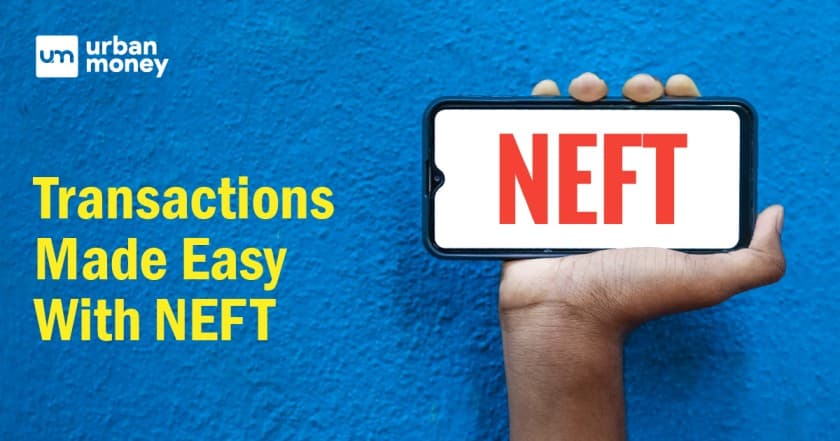NEFT Full Form - Know What is Mean By NEFT?

The world has become digital, of which a major chunk of gratitude goes to the banking system. Banks have revolutionised and provided their customers with digital banking solutions. One such facility is NEFT or National Electronic Funds Transfer which can be defined as an online service that allows customers to use internet banking to perform banking transactions. An NEFT transaction can be made online without any transaction limit.
This piece provides a detailed account of the NEFT facility and helps you understand what is NEFT transfer.
- Personalized solutions
- Expert guidance
- Application assistance
- Credit score discussion
- Interest rate comparison
Table of Content


Last Updated: 15 December 2025
What is NEFT Full Form in Banking
NEFT full form in banking stands for National Electronic Funds Transfer. It is an online facility introduced by the Reserve Bank of India (RBI) to transfer funds from one bank account to another quickly.
What is NEFT?
Any individual can facilitate direct one-to-one payments across the country via the NEFT, or National Electronic Funds Transfer, an electronic payment system. It is mandatory for both parties involved, the benefactor and beneficiary, to have a bank account at any branch. NEFT transactions can also be performed online through internet banking and mobile banking. This quick and hassle-free tool promotes electronic transactions by excluding the paperwork and eliminates the risk of transaction failure due to an error in the NEFT mandate form.
Prerequisite Before Performing the NEFT Transaction
To avoid confusion, the benefactor must know the bank details of the beneficiary or the entity receiving their money. The portal requires the payer to enter the following details to process an NEFT transaction successfully:
- The Beneficiary’s name
- Beneficiary’s account number
- Beneficiary’s account type
- Name of the beneficiary’s bank
- The beneficiary’s account’s branch name
- IFSC of the beneficiary’s branch
How does an NEFT Transaction work?
The NEFT facility can be utilised to facilitate the transfer of funds quickly. This method gives a breakdown of the whole process from start to finish.
- A beneficiary must be added as a first step.
- After enrollment, the bank needs a few minutes or hours to activate the newly registered beneficiary
- Once activated, you can transfer the money.
- Your bank generates a message and sends it to its NEFT service centre after you complete an NEFT transaction.
- The NEFT service centre sends the message to the RBI-run NEFT clearance centre.
- The clearing centre then coordinates the destination bank’s requests for payment processing. It sets up a financial transaction to take the sender’s funds and credit them into the recipient’s account.
- The receiving banks’ NEFT service centre sends a payment message to the benefactor.
- The destination bank receives the inbound transfer notifications from the clearing centre and credits the appropriate amount to the beneficiary’s account.
National Electronic Fund Transfer Process
Instead of withdrawing the funds and then paying them in cash or writing a check, an individual can transfer a certain amount of money from his bank account to another person’s bank account via the NEFT process. The main advantage of NEFT is the flexibility with which money can be transferred from one bank account to another, regardless of location. The sender and destination branches must offer NEFT facilities to facilitate the transaction. You can confirm the list of bank branches that support NEFT on the RBI website or by calling the customer care line at your bank. Under the Indo-Nepal Remittance Facility Scheme, the NEFT procedure allows the cross-border, one-way transfer of funds between India to Nepal.
Steps To Transfer Money Through NEFT
An NEFT transfer requires the bank’s IFSC code in addition to other details such as the account holder’s name, bank account number, bank branch, and other details.
- Log into your online banking account using your user ID and password.
- Visit the website for NEFT Fund Transfer.
- Specify the IFSC code, recipient name, and bank account number.
- You should start an NEFT transfer, once the beneficiary is connected successfully.
Eligibility Criteria to Transfer Money Via NEFT
Anyone, including corporations and businesses, who has maintained a checking or savings account is qualified to transfer funds through NEFT. This facility can be availed of to transfer funds between accounts from the same and other banks. However, the user is required to enter the necessary information accurately to conclude the transaction effectively. Any errors or inconsistencies would lead to a failed transaction.
Features and Benefits of NEFT
NEFT in banks offer the following benefits and features apart from presenting a platform to transfer funds from one place to another conveniently.
- It is among the quickest and safest ways to transfer money.
- It enables the transfer of funds between accounts from the same bank and accounts from other banks.
- You can avail of this facility 365 days a year.
- The money will be placed into the beneficiary’s account within minutes.
- You can facilitate the transaction easily by simply logging into your net banking account
- There is no need to fill out the NEFT mandate form.
Major Banks Providing NEFT Facility
Offering a facility like NEFT in banks is a necessity in the modern world.NEFT is the most widely used service among the three options available to carry out a transaction – NEFT, RTGS and IMPS. The major banks mentioned below provide their customers with the convenience of transferring money anytime anywhere.
| Axis Bank Limited | AU Small Finance Bank | State Bank of India |
| Bank of India | ICICI Bank | Kotak Mahindra Bank |
| Canara Bank | Union Bank | Federal Bank Limited |
| DCB Bank Limited | IDBI Bank Limited | Indian Bank |
| Bank of Maharashtra | Central of India | DBS Bank Limited |
| HSBC Limited | IDFC First Bank Limited | Indian Overseas Bank |
| Standard Chartered Bank | Punjab National Bank | |
What is NEFT Transfer Limit
The Reserve Bank of India has not provided guidelines regarding the limit on NEFT payments. There are no maximum or minimum transaction limits, but the banks can set one to keep the risk at bay. This imposition by banks requires board approval.
Chances of Failure of NEFT Fund Transfers
Being a facility that requires the internet to transfer funds, the system can always crash due to a heavy flow of payment attempts. Another reason that could cause a failure of an NEFT transaction is a technical glitch or the absence of an internet connection while processing transactions.
The customer, in this case, must remember that the bank and the RBI record all the transactions. If the payment fails, one can visit the bank branch or wait 2-3 working days for the amount to be processed or credited back to the remitter’s account. One can also contact their bank’s customer care service and file a complaint.
Are there any restrictions for NEFT transactions?
There are no restrictions on using NEFT to make a payment; however, a bank may impose a time limit and a transaction limit if they get approved by the board.
What are the Charges Applicable for NEFT Transactions
National Electronics Fund Transfer (NEFT) spearheaded the transformation of the payment system in the country. Its convenience has been accentuated by its Pan-India reach and accessibility via online and offline avenues. Additionally, the Reserve Bank of India (RBI) manages and oversees NEFT transactions, making the system exceptionally safe and secure for transferring funds. Savings account holders who initiate NEFT payments through online or offline channels with a debit card or credit card may incur fees. These fees, however, could differ from bank to bank. A customer must know that no fees are incurred when receiving money through NEFT.
Why is NEFT the most Preferred Mode of Fund Transfer?
The NEFT is the most availed fund transfer service compared to RTGS and IMPS. The biggest factor that influences an individual to make an NEFT transaction is the absence of a transaction limit. Another influencing factor is the NEFT time. Unlike RTGS, NEFT users get an extra hour to make a transaction.
How Much is the NEFT Settlement Time?
NEFT in banks runs around the clock, irrespective of the social or economic environment. An NEFT time works in batches that are settled in 30 minutes, leading to a total settlement time of 48 hours.
The time to settle the first batch of NEFT Transactions is set to commence at 12:30 am and concludes at 12:00 am. The short window for NEFT settlement enables the bank to facilitate more transactions.
It should be emphasised that all NEFT payments that occur within regular bank business hours are regarded as automated transactions that are started by the banks using “Straight Through Processing” (STP) protocols.
FAQ's About NEFT
What is the NEFT of a bank?
NEFT, an abbreviation of National Electronic Funds Transfer, is a facility a bank offers to allow its customers to easily make an online transaction easily. There is no minimum or maximum limit amount.
What is the difference between NEFT and RTGS?
The primary difference between the NEFT and RTGS is the limit on the transaction amount. The minimum amount to use the RTGS facility should be INR 2 lakhs, whereas NEFT has no upper or lower limit.
Which is faster, NEFT or RTGS?
The transactions made under RTGS get transferred immediately, whereas NEFT transactions take approximately 2 hours to process.
Is NEFT transfer immediate?
No, NEFT transfer is not immediate. It takes up to 2 hours to process a particular transaction.
Can I cancel the NEFT transfer?
Once the transaction is initiated, you cannot cancel the NEFT transfer.
Can I do the NEFT transfer on the weekend?
Yes, you can do the NEFT transfer on the weekend. However, there is a time frame to make the transfers, after which the transactions will be processed the next day.
